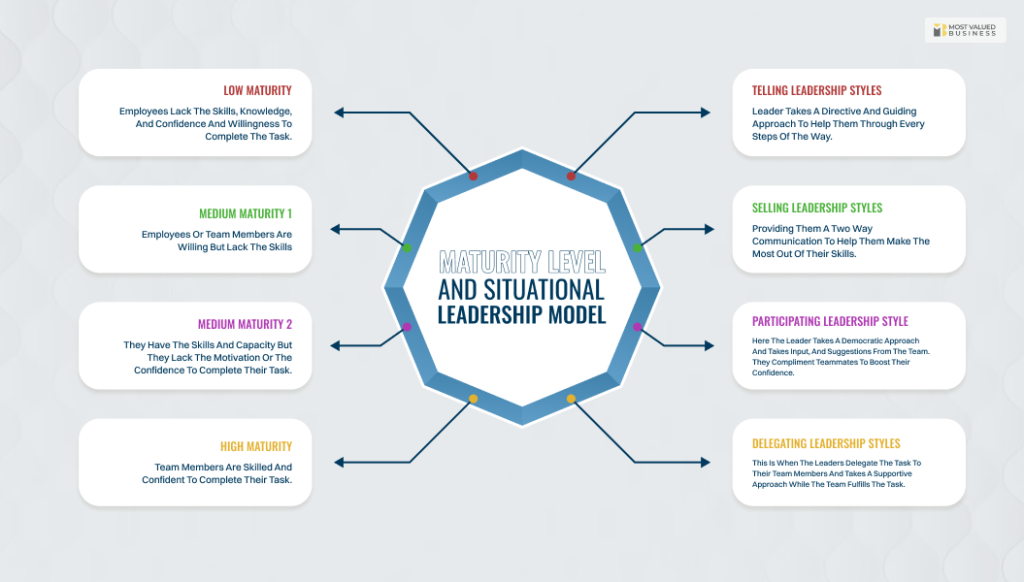What Is A Situational Leadership Model? Characteristics, Pros & Cons
It would not be too incorrect to think of managing a group of people like parenting children throughout different life stages. I know this sounds a little corny. But, like parents, a manager, too, needs to adapt their managerial skills or leadership styles from time to time. This brings a situational leadership style in front of us.
Before we dive deep, we can think of different stages of an employee’s life where they need different approaches from their managers. For example, someone starting their career may need a manager who guides them through every little step of the way.
But, when you already have mastery over the skills needed for your current job role, you need a manager who lets you be. To sum it all up, a situational leader adapts their leadership style from time to time. They can take different approaches based on the changing landscape of their respective businesses and according to the different parameters below –
- Team
- Work environment
- Organization
Read this article to find out what situational leadership style is and how it can help.
What Is Situational Leadership Theory?

It is undeniable that in today’s age, we have different types of people working together. As a leader, it is way too difficult to deal with all the different types of people who come from different backgrounds: personality, ego, experience, motivators, and different learning styles. A situational leadership style is adjusting one’s leadership style according to all of these different variables.
A leader who adapts their leadership style according to the team’s needs or the team’s situation is, in a general sense, a situational leader. SituationalSituational leaders can adapt themselves and their leadership style according to the task and situation and help their team meet their goal and needs.
The situational leadership style came into existence through the hands of Paul Herse in 1969. When the style was developed, it was named a “one size fits all” leadership style. This leadership style provides a leader with a framework that allows the performance readiness level of a team or an employee to complete any task.
Read More: 10 Leadership Goals That Will Help Your Business Reach Sky Highs!
How Does The Situational Leadership Model Work?

The situational leadership model allows a manager to adapt themselves to differentiate changing situations. They can change their leadership behaviors according to the strengths and weaknesses of their teams and a changing environment.
The fundamentals of situational leadership style are for the leaders to follow their team members’ willingness and performance readiness. The employees’ willingness and ability can vary across different situations and performance areas. This leadership style also considers the degree of support and the direction the employees require from their leaders.
There is a sense of flexibility that motivates the employees to feel empowered and energized by their leaders. A leader following this leadership style can bring out the best in their different team members.
Situational leaders regulate their leadership approach according to the performance level and the willingness of their teammates’ side. They have a different approach for a tenured employee with more experience than what they have for a new employee who needs more intervention from their team leader.
Maturity Level & Situational Leadership Model
An employee or team member has four different levels of maturity levels. A situational leader can follow four different leadership styles under the situational leadership model based on the employee’s maturity level, willingness to perform, and abilities. Here are the different maturity levels defined for the employees in different stages –
There are four different maturity levels of a team member. Leaders can use varying leadership styles based on these different levels of maturity levels –

- Low maturity Level – Telling Leadership Styles
- Medium maturity Level – Selling Leadership Styles
- Medium maturity Level – Participating Leadership Style
- High maturity Level – Delegating Leadership Styles
Situational leadership Model: 4 leadership styles

The situational leadership model is a specific leadership model with different leadership styles. There are four distinct leadership styles under this leadership style, and the leader can choose any of them based on the performance readiness of their teammates. Here are the four different leadership styles under situational leadership.
Telling Leadership Style
When the team or the team member is the newest recruit or has less experience, a telling leadership style is most suited for them. Such team members or groups require more supervision or guidance from the leader. A situation like this requires directive behavior from the team leaders to help the team execute the task. Sometimes, they have to supervise team members or take charge when needed.
Selling Leadership Style
Selling leadership is needed when the team is unable but willing to fulfill their duty or task. A situational leader has to provide two-way communication to help the team perform at their current best level. They reinforce a small level of success at this point. Leaders using a selling leadership style can try to improve the skills and competencies of their team.
Participating Leadership Style
A participating leadership style is necessary when the teammate or the team has achieved the skills and competencies to perform any specific task. Here, the leader has a more democratic approach to their teammates. They allow their team or the team members to provide input and ideas from their areas of skills and expertise. The leaders also compliment their team members’ work to boost their confidence.
Delegating Leadership Style
A delegating leadership style is the peak level of situational leadership style. When the team members gain their skills, confidence in their work, and are self-motivated, their leaders can delegate tasks and projects to them.
A leader who leverages this leadership style can –
- Set a vision
- Outline their desired outcomes.
- Give clear authority
A leader at this point takes a more supportive approach and lets their team perform the delegated task without any intervention. It is a way of letting someone new take over or take the helm of a particular task or project.
When To Use A Situational Leadership Style?

A situational leadership style needs to be aligned with the performance readiness model for it to be effective. It can help the team members boost their productivity level, skills, and competencies. Here are a few examples of when this leadership approach is at its peak level of effectiveness –
Unable, Unwilling Or Insecure Team Members
Situational leadership is required when the team members are still developing themselves and do not yet have the skills ready for the tasks assigned to them. They need a directive leadership approach in such situations. A leader might need more of a directive style of leadership approach here. They need to help their team members with guides related to the ‘how to,’ when, and what to do.
Confident But Unable Team Mates
A situational leadership style aligns the style with the performance and the willingness of the teammates. It might be needed when the team has the skills, but they are not fully developed to fulfill a particular task. The team is confident but is not fully engaged with the mission.
So, a situational leader can use their effective skills of coaching and help the teams with problem-solving. They can also engage the team members in the process and help them complete the task.
Able But Unwilling Or Insecure Team Members
Sometimes, the teammates are highly skilled and may even surpass their team leads. But they lack the confidence to perform the task at hand. Most of the time, such employees feel insecure about performing their tasks for the first time.
This is when a situational leader has to provide their support and encouragement to help their teams take the risks necessary. A team leader can encourage the team to use their skills and the knowledge they have to deal with the situation. Here, they provide the support the team needs while the team takes care of the task.
Confident, Secure, And Able Team
When the team members are highly skilled and confident, they are ready to have their own tasks delegated to them. A situational leader, at this point, delegates different tasks and responsibilities to these highly confident and skilled team members.
When the team has matched the skilled and competency level and has the confidence, the best way to support them is through delegation of tasks. The leader empowers their team members to work independently at this point.
| Pros | Cons |
|---|---|
| A situational leadership style is easy to understand. It is a flexible leadership style. Employees have a comfortable environment with a situational leader taking the helm. Teams can work together better with a situational leadership style shaping the work culture. It is a performance enhancing leadership style. | Managers have to face a great level of difficulty sometimes. Its flexibility can shift team’s attention from a long term goal. Sometimes this leadership style can cause confusion. A situational leadership can be stressful. This leadership style can also be inefficient. |
Characteristics Of Situational Leadership Style
Most leaders usually have a particular leadership style or way of leading people. It is common to develop a comfort zone around one’s leadership style, which is why it might often be challenging to develop this leadership model into one’s leadership method. Here are some examples of how you can follow a situational leadership style.
They Are Flexible
A situational leader is always flexible according to the needs, the tasks, and the organizational goals. They can adjust their leadership approach and bring out the best in their teams.
Active Listener
Situational leaders need to develop good skills for active listening. Their attentive listening can help the team feel understood and help them solve any complicated situation. Their patience can help their team and the organization during dire situations.
Providing Right Direction
A situational leader is always clear about the direction they provide their team. They help their team with direction and the necessary level of support according to their needs. A leader following the situational leadership model has the flexibility of mind and active listening to understand where their team is willing to go. They can provide the right amount of support or the necessary direction to their team to help them achieve their goals.
Encouraging Team Members
A situational leader has a very distinct behavioral approach. They can create a psychologically safe environment and provide their team with opportunities to flourish. Team members can share their experiences, thoughts, and input thanks to their encouraging personality. They are also skillful when it comes to delegating authority to their team members.
Coaching Skills
Becoming an effective situational leader requires one to develop efficient coaching skills. They can coach their team members regarding different areas that might require improvement or development. This skill allows a team leader to regulate themselves to reach their team members’ level and guide them to where they want to be.
Read More: What Is The Importance Of Leadership Development In Business?
Final Words
Although situational leadership has different benefits for the organization, it can cause too much pressure on the leader. Besides, this leadership style focuses on short-term goals in general. Also, while the leader is constantly regulating their leadership approach from time to time, the followers might seem a little confused. On the contrary, a situational leader can help develop their team members to a certain level of skill.
They can also boost the team’s productivity and help the organization reach its goal in time. Hopefully, this article was helpful. Please let us know your feedback on the same. Thank you for reading.
Read Also:



